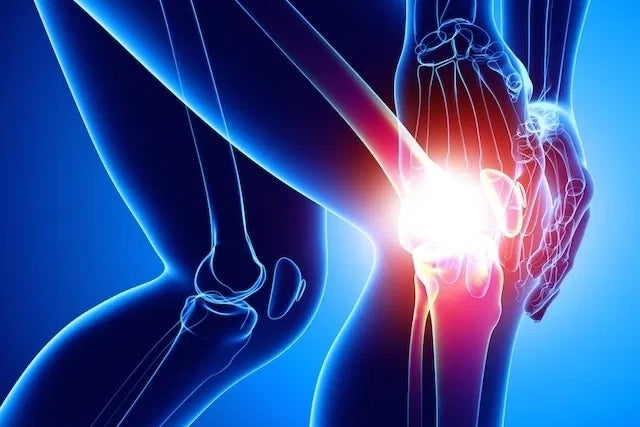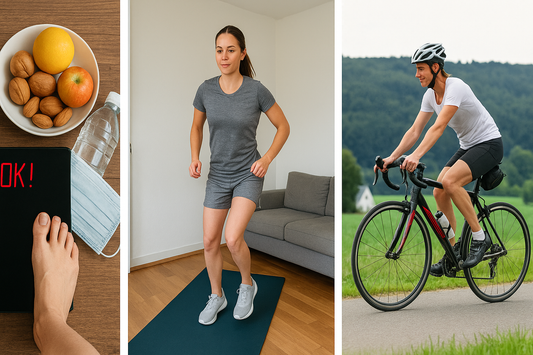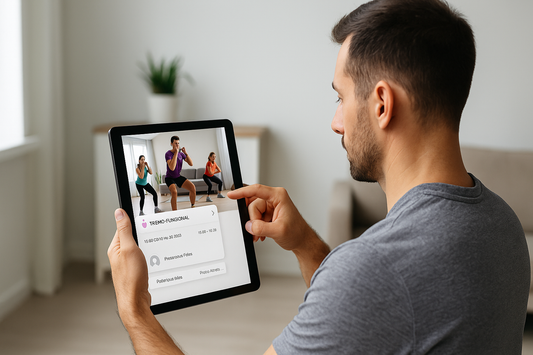
Knee pain: 11 causes and how to prevent it
Share
Knee pain is a symptom that can arise due to wear and tear on the joint, excess weight or sports injuries, such as those that can occur in a football match or during a run, for example.
However, when knee pain prevents walking or worsens over time, it may be a sign of a more serious problem, such as a torn ligament, osteoarthritis or a Baker's cyst, which can be confirmed through tests such as an X-ray or CT scan.
However, knee pain is not serious in most cases and can be treated at home by applying ice twice a day for the first 3 days after the pain begins. In addition, wearing an elastic bandage on your knee throughout the day can help immobilize it, reducing pain while you wait for your appointment.
The main causes of knee pain are:
1. Trauma injury
Trauma to the knee can occur due to a fall, contusion, blow, knee twist or fracture, for example. In these cases, pain can occur throughout the knee or in specific areas depending on the location of the injury.
What to do: In the case of minor injuries, without fractures, you can rest and apply an ice pack 2 to 3 times a day for 15 minutes. However, in more serious cases, such as fractures, you should seek medical help immediately to begin the most appropriate treatment. Physiotherapy may also be recommended to aid recovery and relieve pain, even in mild cases.
2. Ligament rupture
A torn knee ligament can occur from a sprain caused by a strong blow or twisting of the knee during a sudden change of direction, for example. The type of pain usually indicates which ligament was torn:
- Lateral knee pain: may indicate injury to the anterior or posterior cruciate ligaments or coronary ligament;
- Knee pain when stretching the leg: may indicate a ruptured patellar ligament;
- Knee pain on the inside: may indicate injury to the medial collateral ligament;
- Deep pain, right in the middle of the knee: could be a rupture of the anterior or posterior cruciate ligaments.
Generally, when the ligament rupture is mild, no specific treatment is necessary, but it should always be evaluated by an orthopedist or physiotherapist.
What to do: You can apply ice packs 3 to 4 times a day for 20 minutes for 3 to 4 days, rest, use crutches to avoid putting strain on your knees, elevate your leg to prevent swelling, and use an elastic bandage on the affected knee. In more severe cases, it is important to seek medical attention, which may require immobilizing the knee with a splint for 4 to 6 weeks and, if necessary, surgery. See other treatment options for torn knee ligaments.
3. Tendonitis
Tendonitis is an inflammation of a tendon in the knee and the type of pain varies depending on the location of the tendon:
- Pain in the front of the knee: indicates inflammation in the patellar tendon;
- Pain on the side of the knee: indicates inflammation in the iliotibial tendon;
- Pain on the inside of the knee: indicates inflammation in the pes anserinus tendons.
Generally, one of the characteristic symptoms of tendonitis is knee pain when stretching the leg and is more common in athletes, due to the impact of physical activities such as running, cycling, football, basketball or tennis. In addition, it can occur due to natural wear and tear of the joint, and is also common in the elderly.
What to do: Rest and use an elastic bandage on the affected knee. Applying ice packs for 15 minutes, 2 to 3 times a day, can help relieve pain and combat inflammation. It is important to consult an orthopedist for further evaluation and treatment with anti-inflammatories such as ibuprofen or naproxen, for example. In addition, physical therapy can be done to strengthen the knee muscles and prevent tendonitis from developing again. See other ways to treat tendonitis in the knee.

4. Bursitis
Bursitis is the inflammation of the bursa, which is a small sac that contains fluid and acts as a shock absorber, in addition to reducing friction between the bones, tendons and muscles of the joints.
The knee has 11 bursae and generally activities such as bending the knee or kneeling repeatedly, sports such as jiu-jitsu, football and volleyball, falls or blows can cause irritation and inflammation of the bursa causing prepatellar bursitis which causes pain in the upper part of the knee and swelling.
In addition, obesity or osteoarthritis can cause anserine bursitis, also called pes anserine bursitis, which causes pain in the knee on the inside just below the joint.
What to do: Rest and apply an ice pack for 15 minutes, 2 to 3 times a day. In addition, since bursitis is an inflammation, it should be treated with oral anti-inflammatories such as ibuprofen or diclofenac, for example, or the doctor may inject corticosteroids directly into the bursa. Other treatments include physical therapy and surgery. Check out exercises that can be done to prevent bursitis in the knee.
5. Osteoarthritis
Osteoarthritis, or arthrosis, in the knee is a rheumatic disease that causes degeneration of the knee cartilage, reducing the quality, quantity and thickness of this cartilage, causing chronic pain.
This disease can impact daily activities by causing knee pain when walking, at the end of the day, from standing for a long time or knee pain when climbing stairs, for example.
What to do: It is important to consult an orthopedist, as treatment should be done with painkillers such as paracetamol or anti-inflammatories such as ibuprofen or diclofenac. In addition, physiotherapy sessions are also recommended and, in some cases, the doctor may inject corticosteroids or hyaluronic acid into the affected knee. See how physiotherapy can be done for osteoarthritis.
6. Rheumatoid arthritis
Rheumatoid arthritis is a chronic, inflammatory autoimmune disease that causes stiffness, pain, and swelling in the joints. Knee pain upon waking may be caused by rheumatoid arthritis, and the pain is most intense during the first few minutes of the morning and improves with movement.
Additionally, knee pain that occurs with swelling but has not been caused by trauma may indicate rheumatoid arthritis.
What to do: You can use analgesics and anti-inflammatories to relieve pain, but you should see a rheumatologist to assess the progression of the disease and a physiotherapist to improve knee movement. Learn more about treating rheumatoid arthritis.

7. Iliotibial band syndrome
Iliotibial band syndrome causes pain on the side of the knee and is very common in runners, cyclists or those who practice other sports that require the knee to bend repeatedly. This syndrome is usually related to muscle weakness and poor flexibility or training errors with inadequate intensities and volumes, in addition to the conditions in which the sport is practiced, such as the terrain, type of shoes or poor posture, for example. This type of pain should not be ignored as it can worsen over time.

What to do: you can use anti-inflammatory ointment 2 to 3 times a day or apply a cold compress for 15 minutes. Before doing any physical activity, it is important to invest in muscle-strengthening activities such as weight training or stretching, always under the guidance of a physical trainer. However, if the pain on the side of the knee occurs while already doing physical activity, it is best to consult an orthopedist for a correct diagnosis and treatment with anti-inflammatories such as diclofenac or ibuprofen, for example, in addition to physical therapy to strengthen the muscles. Learn how to cure iliotibial band syndrome.
8. Meniscus injury
Knee pain when bending the leg, pain on the inside of the knee, pain when climbing stairs, pain when squatting or pain inside the knee, for example, may indicate an injury to the meniscus, which is a disc that acts as a cushion or shock absorber inside the knee. Generally, meniscus injuries are caused by physical activities such as judo, jiu-jitsu or by natural degeneration, which is the aging of the meniscus and which can begin around 40 years of age.

What to do: Rest should be taken and activities that involve excessive movement of the knee should be avoided. Physiotherapy should be performed to strengthen the knee muscles. In some cases, the doctor may also inject corticosteroids or hyaluronic acid into the knee. In more severe cases, surgery may be recommended.
9. Patella problems
Other common causes of knee pain are problems with the patella, such as chondropathy patella, which is the wear and tear of the joint around the patella, or chondromalacia patella, which is the softening of the cartilage of the patella. The causes of problems with the patella are usually aging, obesity, flat feet or sports such as running, for example.
Patella injuries can cause knee pain when squatting or knee pain when walking down stairs, as well as a feeling that the knee is slipping out of place.
What to do: For runners, it is advisable to temporarily change sports to swimming or water aerobics until the knee muscles are strengthened. Physical therapy can help strengthen the knee and, after the pain has eased, you can do strength training guided by a physical educator. In addition, the doctor can inject hyaluronic acid into the knee and, in more severe cases, surgery may be recommended.
10. Baker's cyst
A Baker's cyst, also known as a popliteal cyst, is a lump that forms behind the knee joint due to fluid accumulation and causes pain in the back of the knee, swelling, stiffness and pain when bending the knee, which worsens with physical activity. Causes of a Baker's cyst include osteoarthritis or rheumatoid arthritis, for example.
What to do: You should rest and consult an orthopedist to aspirate fluid from the cyst or inject corticosteroid directly into the cyst. If the cyst ruptures, treatment is surgical. Learn more about how to treat a Baker's cyst.
11. Osgood-Schlatter disease
Osgood-Schlatter disease is an inflammation of the patellar tendon and is related to rapid growth, and can occur in children aged 10 to 15. Pain usually occurs after physical activities such as soccer, basketball, volleyball or Olympic gymnastics, for example, and can cause pain in the lower part of the knee that improves with rest.
What to do: You should rest and limit the physical activities that cause pain. You can apply an ice pack for 15 minutes, 2 to 3 times a day, or apply anti-inflammatory ointments to the painful area. It is also important to see an orthopedist.
Diet for knee pain
Enriching your daily diet with foods with anti-inflammatory properties, such as salmon, ginger, turmeric, saffron, crushed garlic or chia seeds, helps to complement the treatment of knee pain and prevent pain in other joints. Learn more examples of anti-inflammatory foods that you should consume in greater quantities on days of pain.
In addition, you should avoid foods that are too sugary, as they aggravate inflammation in any part of the body.
Alternative Treatment for Knee Pain
Knee pain can usually be treated with anti-inflammatory medications prescribed by an orthopedic surgeon, such as Diclofenac or Ibuprofen, or surgery to replace damaged portions of the knee. However, alternative treatments for knee pain can be used, especially for those with sensitive stomachs to anti-inflammatory medications, and include:
- Homeopathy: use of homeopathic remedies, such as Reumamed or Homeoflan, prescribed by an orthopedist, to treat knee inflammation caused by arthritis or tendonitis, for example;
- Acupuncture: this technique can help relieve knee pain related to arthritis, osteoarthritis or trauma, for example;
- Compresses: apply hot compresses with 3 drops of sage or rosemary essential oil twice a day, starting on the 3rd day after symptoms appear;
- Knee rest: involves bandaging the knee, especially when it is necessary to remain standing for a long time.
In addition, you should avoid running or walking whenever you have knee pain, and avoid lifting heavy objects or sitting on high chairs to avoid straining your knees when standing up.
Alternative treatment for knee pain should not replace the treatment prescribed by your doctor, as it can worsen the problem that caused the knee pain.
When to see a doctor
It is important to consult an orthopedist or physiotherapist when:
- The pain lasts more than 3 days , even after rest and application of cold compresses;
- The pain is very intense when doing daily activities such as ironing while standing, carrying a child, walking or climbing stairs;
- The knee does not bend or make noise when moving;
- The knee is deformed ;
- Other symptoms such as fever or tingling appear ;
In these cases, the orthopedist may request an x-ray or an MRI to diagnose the problem and recommend appropriate treatment.
What is the right training program for me?
We recommend that you check which training program is best suited for you. Find out which training program is right for you where after completing the questionnaire we will help you identify the ideal training plan based on your goals and fitness level, ensuring more efficient and targeted development.
Revenues:
- Chicken Salad with Quinoa and Avocado
- Recipe: Protein Pancakes
- Chicken Salad with Quinoa and Avocado
- Recipe: Banana Smoothie with Rice and Oat Milk
- Green Detox Smoothie Recipe
Other topics:
Challenge of the day | Tips | Training
Suggested services:
Diagnosis, assessment/reassessment | Planning | Accompanied training
Suggested ebooks:
100 No Excuses Workouts | Amateur race | Fitness Detox
Suggested training programs:
Military training | Metabolic training
Where to buy Food Supplements
Whey protein 900g chocolate flavor
Creatine monohydrate with Creapure® seal 240 capsules
Omega-3 Supplement
For more tips on training and health care, keep following our articles at www.treinoemcasa.com .



